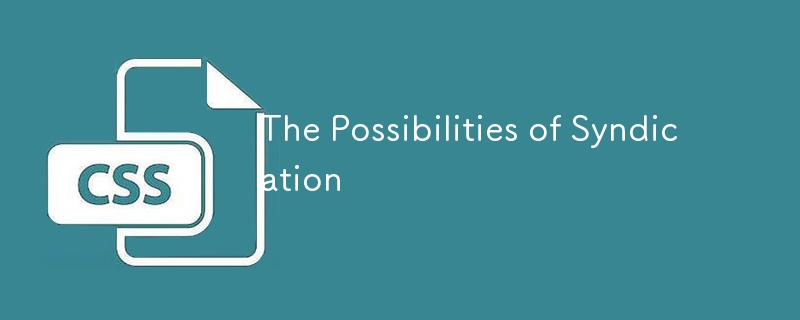The Possibilities of Syndication

That’s the one word that isn’t an adjective in the acronym RSS.
Really Simple Syndication.
Update: Lol there are literally two mistakes there. RSS is an initialism not an acronym, and “Really” is an adverb not an adjective.
RSS isn’t just about RSS readers. Even though, gosh if I don’t love RSS readers. It’s about putting content in a format that is designed to be portable. An API for content isn’t a metaphor, that’s literally what it is.
RSS is always on my mind, because it’s like my daily newspaper, but I’d wager it’s not exactly at the peak of people’s attention, even developers. It’s been getting a smidge of attention though, as Google is dipping it’s toes back into RSS with a “following” feature in Android Chrome. Publishers (like me) are always interested in ways we can help people read our stuff, and in this case, the way we help is by having an RSS feed. Sweet.
But again, it’s not just about reader apps. For example: every single podcast (every single podcast) is an RSS feed. That’s notable to say the least.
I also see apps that take advantage of it in unique ways. MonitoRSS is one of them. The whole point of it is kicking content over to Discord channels by — you guessed it — RSS feeds.
You can also build literal websites from aggregated content. For example, your WordPress site can suck in RSS feeds and re-display the content. I’m not 100% sure how it works but the Sidebar Webring is presumably powered by RSS as well. It’s just like CSS-Trickz. Alex could have used RSS to grab that content, it just so happens WordPress also has a JSON API which is often easier than parsing the XML of RSS. Dave and Robin have used Feedbin’s API to display posts that they read and “like” via RSS.
Having an RSS feed opens doors to all sorts of user-friendly ways for people to follow and read your content, above and beyond RSS readers.
The above is the detailed content of The Possibilities of Syndication. For more information, please follow other related articles on the PHP Chinese website!

Hot AI Tools

Undresser.AI Undress
AI-powered app for creating realistic nude photos

AI Clothes Remover
Online AI tool for removing clothes from photos.

Undress AI Tool
Undress images for free

Clothoff.io
AI clothes remover

Video Face Swap
Swap faces in any video effortlessly with our completely free AI face swap tool!

Hot Article

Hot Tools

Notepad++7.3.1
Easy-to-use and free code editor

SublimeText3 Chinese version
Chinese version, very easy to use

Zend Studio 13.0.1
Powerful PHP integrated development environment

Dreamweaver CS6
Visual web development tools

SublimeText3 Mac version
God-level code editing software (SublimeText3)

Hot Topics
 Vue 3
Apr 02, 2025 pm 06:32 PM
Vue 3
Apr 02, 2025 pm 06:32 PM
It's out! Congrats to the Vue team for getting it done, I know it was a massive effort and a long time coming. All new docs, as well.
 Can you get valid CSS property values from the browser?
Apr 02, 2025 pm 06:17 PM
Can you get valid CSS property values from the browser?
Apr 02, 2025 pm 06:17 PM
I had someone write in with this very legit question. Lea just blogged about how you can get valid CSS properties themselves from the browser. That's like this.
 A bit on ci/cd
Apr 02, 2025 pm 06:21 PM
A bit on ci/cd
Apr 02, 2025 pm 06:21 PM
I'd say "website" fits better than "mobile app" but I like this framing from Max Lynch:
 Stacked Cards with Sticky Positioning and a Dash of Sass
Apr 03, 2025 am 10:30 AM
Stacked Cards with Sticky Positioning and a Dash of Sass
Apr 03, 2025 am 10:30 AM
The other day, I spotted this particularly lovely bit from Corey Ginnivan’s website where a collection of cards stack on top of one another as you scroll.
 Using Markdown and Localization in the WordPress Block Editor
Apr 02, 2025 am 04:27 AM
Using Markdown and Localization in the WordPress Block Editor
Apr 02, 2025 am 04:27 AM
If we need to show documentation to the user directly in the WordPress editor, what is the best way to do it?
 Comparing Browsers for Responsive Design
Apr 02, 2025 pm 06:25 PM
Comparing Browsers for Responsive Design
Apr 02, 2025 pm 06:25 PM
There are a number of these desktop apps where the goal is showing your site at different dimensions all at the same time. So you can, for example, be writing
 How to Use CSS Grid for Sticky Headers and Footers
Apr 02, 2025 pm 06:29 PM
How to Use CSS Grid for Sticky Headers and Footers
Apr 02, 2025 pm 06:29 PM
CSS Grid is a collection of properties designed to make layout easier than it’s ever been. Like anything, there's a bit of a learning curve, but Grid is
 Google Fonts Variable Fonts
Apr 09, 2025 am 10:42 AM
Google Fonts Variable Fonts
Apr 09, 2025 am 10:42 AM
I see Google Fonts rolled out a new design (Tweet). Compared to the last big redesign, this feels much more iterative. I can barely tell the difference






